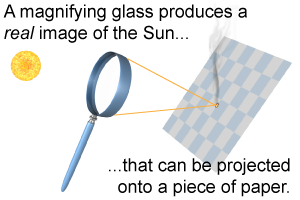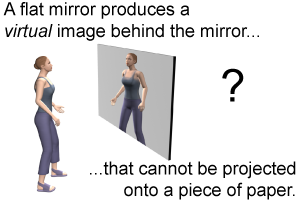|
Optical devices take light from an object and produce an image. Objects are physical things, such as the Sun, the light from a computer monitor, or a blue wall. Images are pictures of those things that are formed when light rays meet. Images can be produced by mirrors, lenses, prisms, or combinations of them. 
|
 There are two kinds of images that you can create with optics: real and virtual images. A real image is a place where light rays physically meet and can be projected onto a piece of paper. You can hold a magnifying glass in the sunlight and focus an image of the Sun onto a piece of paper. The light rays from the Sun that pass through the glass come together to form an image on the paper, which can cause it to catch fire!
There are two kinds of images that you can create with optics: real and virtual images. A real image is a place where light rays physically meet and can be projected onto a piece of paper. You can hold a magnifying glass in the sunlight and focus an image of the Sun onto a piece of paper. The light rays from the Sun that pass through the glass come together to form an image on the paper, which can cause it to catch fire! 
|
 A virtual image occurs when the light rays appear to come together, but they don’t actually do so. This might sound strange. Virtual images are formed behind a flat mirror or in front of a convex lens. Remember when we found that light rays appeared to come together to form an image behind a flat mirror? The light rays aren’t actually coming together behind the mirror—they only appear that way!
A virtual image occurs when the light rays appear to come together, but they don’t actually do so. This might sound strange. Virtual images are formed behind a flat mirror or in front of a convex lens. Remember when we found that light rays appeared to come together to form an image behind a flat mirror? The light rays aren’t actually coming together behind the mirror—they only appear that way! 
|
The practical test for whether an image is real or virtual is to try to project the image onto a piece of paper. Look at the image of yourself in a mirror. Have a friend hold a piece of paper at the location of your image—behind the mirror!—and tell you whether he can see your image on the paper. Not a chance! The light bounced off the front of the mirror; it did not travel behind the mirror. It’s a virtual image! 
|
In Investigation 21B on page 613, you experimented with convex lenses to create different kinds of images. A convex lens, such as a magnifying glass, can create many different kinds of images—depending on where the object is located relative to the lens. When the object is located close to the lens (within the focal length), the image is magnified, virtual, and upright; this is the typical mode for using a magnifying glass. When the object is located between one and two focal lengths from the lens, the image is magnified, real, and inverted. When the object is located farther away, the image is reduced in size, real, and inverted. 
|

 |
In the table above, we left out a few optical devices. In the table below, there are a few other optical devices you worked with in the investigation on page 586. Image properties for additional optical devices | Optical device | Object location | Image type | Image magnification | Image orientation |
|---|
| Flat mirror | Anywhere | Virtual | Same size | Upright | | Rectangular prism | Anywhere | Virtual | Same size | Upright | | Convex mirror | Anywhere | Virtual | Reduced | Upright | | Concave mirror | do > 2f | Real | Reduced | Inverted | | Concave mirror | f < do < 2f | Real | Magnified | Inverted | | Concave mirror | do < f | Virtual | Magnified | Upright | | Convex lens | do > 2f | Real | Reduced | Inverted | | Convex lens | f < do < 2f | Real | Magnified | Inverted | | Convex lens | do < f | Virtual | Magnified | Upright | | Concave lens | Anywhere | Virtual | Reduced | Upright | 
|
Which optical devices can only create real images? Which can only create virtual images? Which can create both?
 |
A rectangular prism, a flat mirror, a convex mirror, and a concave lens can only create virtual images.
A concave mirror and a convex lens create real and virtual images under different circumstances. 
|
For the optical devices that can create real or virtual images in different situations, what factor determines whether the image created will be real or virtual?
 |
The object’s location determines whether the image is real or virtual. When the object is closer to a concave mirror or a convex lens than the lens’s focal point, a virtual image is formed. 
|

